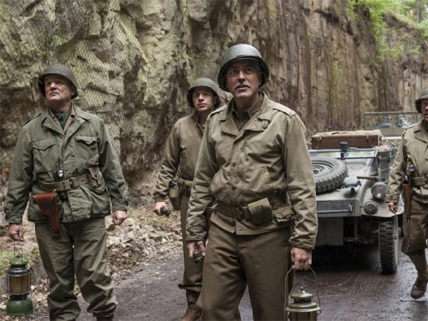The Monuments Men
George Clooney fights a losing battle with a tale of art and war.

The story of the real-life Monuments Men is a good one: how a group of academic art experts was deployed toward the end of World War II to save the treasures of European culture from relentless bombing and thieving Nazis. This adventure would make a good read—and in fact already has, in a 2009 book by Robert M. Edsel. It doesn't make much of a movie, though.
In The Monuments Men, George Clooney, directing his fifth film, plays Professor Frank Stokes, a Harvard art historian. It's 1943, and Stokes has convinced President Franklin Roosevelt to let him form a Monuments, Fine Arts, and Archives unit to be attached to the allied forces that are pushing the German army back out of Italy and France toward its ultimate defeat. The unit's mission: to reclaim the thousands of priceless artworks the Nazis have seized while making their marauding way around Europe—famous paintings (by Manet, Vermeer, Rembrandt), iconic sculptures (Michelangelo's Madonna and Child), and, especially, the priceless Ghent Altarpiece.
Stokes recruits six other art specialists to join his group: one Medievalist (Matt Damon), one architect (Bill Murray), one sculptor (John Goodman), and three men who apparently just know a lot about art (Bob Balaban, Jean Dujardin and Hugh Bonneville). This is a strong cast. But Clooney's script (co-written with his production partner Grant Heslov) divides the actors into separate teams, giving each of them too little screen time to make much of their characters. And their constant peregrinations are hard to keep track of (are we in Aachen now? Nuremberg?) Our attention starts seeping away early on.
Damon manages to register, especially in his scenes with Cate Blanchett (tartly effective as a French resistance member working undercover for the odious Nazi art thief Hermann Göring). Balaban injects occasional low-key humor as a persnickety fish-out-of-water; and Clooney, amiable as ever, has one good moment in which he confronts a detestable Nazi major in an interrogation room. But Goodman is confined to his usual cheery bluster, and Murray, most disappointingly, is wasted.
The story is told in loosely assembled anecdotes, and because it unfolds at such an easygoing, old-fashioned pace, few of them stir much excitement. Some are strained (Goodman and Dujardin have a lethal encounter with a detachment of German soldiers solely because they've stopped by a field to admire a horse), and some—like the scene in which Damon has to be comically lifted off a mine on which he's found himself standing—have a musty war-movie familiarity.
The picture suffers most from its unblushing sentimentality and overripe dialogue. There's an interlude in a field medical tent in which we see grievously wounded soldiers lying on cots while the soundtrack delivers a period rendition of "Have Yourself a Merry Little Christmas." And at one early point, Clooney's character tries to justify his team's elite mission amid the carnage of war by saying, "Who would make sure the Mona Lisa is still smiling?" Really.
Clooney is a fine director, as he has proved with films like Good Night, and Good Luck and Confessions of a Dangerous Mind. But this material, with its dense weave of peculiar characters and art and military history, might defy anyone's attempt to turn it into a two-hour movie. Clooney loses the thread, and he loses us, too.


Show Comments (10)